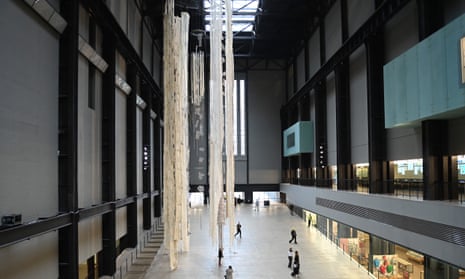The most affecting and mysterious Turbine Hall commission at Tate Modern in a long time, Cecilia Vicuña’s Brain Forest Quipu is a moving lament to a disappearing world, the loss of an ancient language and to the destruction of communities, their ways of life and cultures.
Two large sculptures hang from the roof, falling the entire height of the space, one to the foot of the angled ramp, the other on the far side of the bridge that bisects the space. Pale agglomerations of fraying raw wool, knotted rope and twine, delicate woven netting and suspended braided material sag and fall, sweeping the floor and swaying in the air currents. There are rope-ladders strung with bleached driftwood and bones, tangles and loose coils ravelling and unravelling on the concrete beneath our feet, knitted mesh above our heads and grouped balls of rope dangling in mid-air.
There are so many details in this pair of structures, with their knitted and knotted intervals, their larger raddled sweeps and tiny details – pebble-sized pieces of eroded glass, lamb bones and bits of oyster shell, the remains of long-ago dinners tossed in the River Thames – that you can feel you’ll never get to the end of them. Vicuña acknowledges the delight of looking, of finding and refinding. Many of these mudlarked fragments have been collected by collaborators from London’s Latinx communities. Dangling from twine, like rain arrested in mid-air, these small objects have an almost miraculous quality, as if rescued from the silt of past lives and caught in the turbulence of the present.

Born in Chile, the 74-year-old Santiago and New York-based artist and poet (she has published more than 20 books) studied at the UCL Slade School of Fine Art in London in the early 1970s. After the CIA-supported military coup d’état in Chile in 1973 she stayed in exile, first in London, then in Colombia and Venezuela. In 2009 Vicuña co-edited the highly regarded The Oxford Book of Latin American Poetry. As an artist she is best known for her anti-monumental precarios (precarious), made from found materials. Her work for the Hyundai commission at Tate Modern takes its form from the “quipu”, an ancient measuring, recording and communication system of knotted textile cords used by the Quechua people of the Andes for thousands of years until the Spanish conquest in the 16th century. Vicuña has been adapting the forms of this lost material language in her poetry and art for much of her career.
As much as it is a pair of knotted, woven and braided sculptures, whose presence has the pallor of dead things, bleached vegetation, remnants and last traces, Brain Forest Quipu is an elegy to lost language and wilful destruction. Braided into these sculptures are the sound of birdsong and tumbling water, the accompanying noise of insects, plaintive folk song and the artist’s own voice. We hear string ensembles, guitars and choirs, field recordings and distant, defiant cries. Sometimes the sound feels concentrated in a single place, then another, rising and falling first here, then there. It drifts under the Turbine Hall bridge and weaves among the sculptures themselves, relayed by hidden speakers.
There are passages of keening silence, a chorus of the human and animal, insect hiss and a stumbling marching band. This constant call and response keeps us moving, too. The Turbine Hall is a noisy place, but Vicuña and composer Ricardo Gallo have orchestrated the volume of the space as much as the sculptures themselves. The sound collapses past and present, the human and natural worlds. You feel them shearing. Much more than a background or a soundtrack, the sound brings her sculptures to life, but with a threnody of destruction, loss and the passing of the natural world. As much as they are visually engaging, tactile and rather beautiful, these heartbreaking sculptures also recall dead vines and shedding bark, desiccated gourds and human detritus. I thought of majestic and miserable shrouds swaying in a dry wind.

Comments (…)
Sign in or create your Guardian account to join the discussion